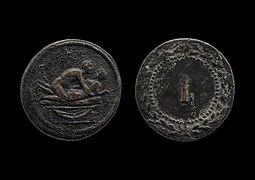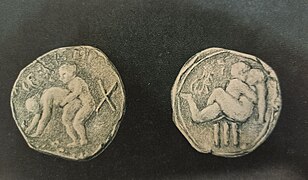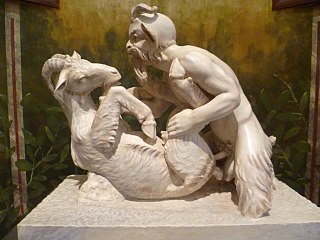
Erotic art in Pompeii and Herculaneum has been both exhibited as art and censored as pornography. The Roman cities around the bay of Naples were destroyed by the eruption of Mount Vesuvius in 79 AD, thereby preserving their buildings and artefacts until extensive archaeological excavations began in the 18th century. These digs revealed the cities to be rich in erotic artefacts such as statues, frescoes, and household items decorated with sexual themes.

In ancient Rome, thermae and balneae were facilities for bathing. Thermae usually refers to the large imperial bath complexes, while balneae were smaller-scale facilities, public or private, that existed in great numbers throughout Rome.
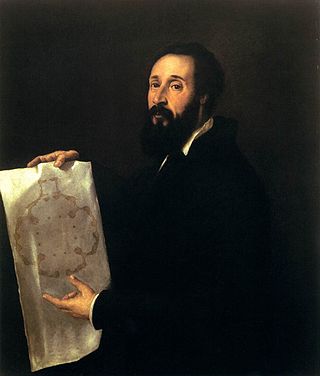
Giulio Pippi, known as Giulio Romano, was an Italian painter and architect. He was a pupil of Raphael, and his stylistic deviations from High Renaissance classicism help define the sixteenth-century style known as Mannerism. Giulio's drawings have long been treasured by collectors; contemporary prints of them engraved by Marcantonio Raimondi were a significant contribution to the spread of sixteenth-century Italian style throughout Europe.

The art of Ancient Rome, and the territories of its Republic and later Empire, includes architecture, painting, sculpture and mosaic work. Luxury objects in metal-work, gem engraving, ivory carvings, and glass are sometimes considered to be minor forms of Roman art, although they were not considered as such at the time. Sculpture was perhaps considered as the highest form of art by Romans, but figure painting was also highly regarded. A very large body of sculpture has survived from about the 1st century BC onward, though very little from before, but very little painting remains, and probably nothing that a contemporary would have considered to be of the highest quality.

I Modi, also known as The Sixteen Pleasures or under the Latin title De omnibus Veneris Schematibus, is a famous erotic book of the Italian Renaissance that had engravings of sexual scenes. The engravings were created in a collaboration between Giulio Romano and Marcantonio Raimondi. They were thought to have been created around 1524 to 1527.
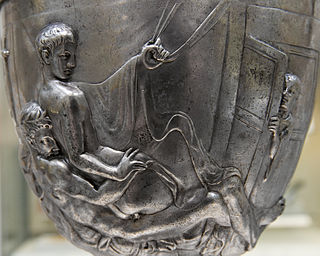
The Warren Cup is an ancient Greco-Roman silver drinking cup decorated in relief with two images of male same-sex acts. It was purchased by the British Museum for £1.8 million in 1999, the most expensive single purchase by the museum at that time. It is usually dated to the time of the Julio-Claudian dynasty.

The Secret Museum or Secret Cabinet in Naples is the collection of 1st-century Roman erotic art found in Pompeii and Herculaneum, now held in separate galleries at the National Archaeological Museum in Naples, the former Museo Borbonico. The term "cabinet" is used in reference to the "cabinet of curiosities" - i.e. any well-presented collection of objects to admire and study.

A frigidarium is one of the three main bath chambers of a Roman bath or thermae, namely the cold room. It often contains a swimming pool.

In numismatics, token coins or trade tokens are coin-like objects used instead of coins. The field of token coins is part of exonumia and token coins are token money. Their denomination is shown or implied by size, color or shape. They are often made of cheaper metals like copper, pewter, aluminium, brass and tin, or non-metals like bakelite, leather and porcelain.

Homosexuality in ancient Rome often differs markedly from the contemporary West. Latin lacks words that would precisely translate "homosexual" and "heterosexual". The primary dichotomy of ancient Roman sexuality was active / dominant / masculine and passive / submissive / feminine. Roman society was patriarchal, and the freeborn male citizen possessed political liberty (libertas) and the right to rule both himself and his household (familia). "Virtue" (virtus) was seen as an active quality through which a man (vir) defined himself. The conquest mentality and "cult of virility" shaped same-sex relations. Roman men were free to enjoy sex with other males without a perceived loss of masculinity or social status as long as they took the dominant or penetrative role. Acceptable male partners were slaves and former slaves, prostitutes, and entertainers, whose lifestyle placed them in the nebulous social realm of infamia, so they were excluded from the normal protections accorded to a citizen even if they were technically free. Freeborn male minors were off limits at certain periods in Rome.

The Villa Poppaea is an ancient luxurious Roman seaside villa located in Torre Annunziata between Naples and Sorrento, in Southern Italy. It is also called the Villa Oplontis or Oplontis Villa A. as it was situated in the ancient Roman town of Oplontis.

The history of erotic depictions includes paintings, sculpture, photographs, dramatic arts, music and writings that show scenes of a sexual nature throughout time. They have been created by nearly every civilization, ancient and modern. Early cultures often associated the sexual act with supernatural forces and thus their religion is intertwined with such depictions. In Asian countries such as India, Nepal, Sri Lanka, Japan and China, representations of sex and erotic art have specific spiritual meanings within native religions. The ancient Greeks and Romans produced much art and decoration of an erotic nature, much of it integrated with their religious beliefs and cultural practices.
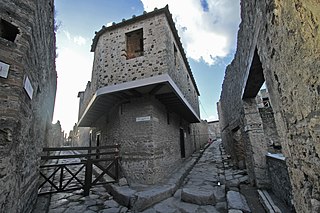
The Lupanar is the ruined building of an ancient Roman brothel in the city of Pompeii. It is of particular interest for the erotic paintings on its walls, and is also known as the Lupanare Grande or the "Purpose-Built Brothel" in the Roman colony. Pompeii was closely associated with Venus, the ancient Roman goddess of love, sex, and fertility, and therefore a mythological figure closely tied to prostitution.

The Suburban Baths are a building in Pompeii, Italy, a town in the Italian region of Campania that was buried by the eruption of Mount Vesuvius in 79 AD, which consequently preserved it.
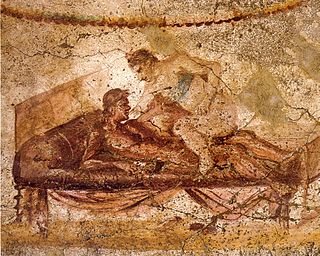
Prostitution in ancient Rome was legal and licensed. Men of any social status were free to engage prostitutes of either sex without incurring moral disapproval, as long as they demonstrated self-control and moderation in the frequency and enjoyment of sex. Brothels were part of the culture of ancient Rome, as popular places of entertainment for Roman men.
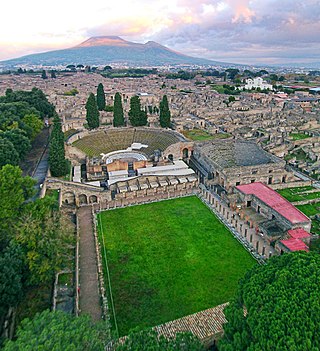
Pompeii was an ancient city in what is now the comune of Pompei near Naples in the Campania region of Italy. Along with Herculaneum, Stabiae, and many surrounding villas, the city was buried under 4 to 6 m of volcanic ash and pumice in the eruption of Mount Vesuvius in 79 AD.
Theodore Vern Buttrey Jr. was an American educator, classicist and numismatist. He is perhaps best known for his work discovering and exposing a scheme to distribute fake Western American gold bars.

The preservation and extensive excavations at Ostia Antica have brought to light 26 different bath complexes in the town. These range from large public baths, such as the Forum Baths, to smaller most likely private ones such as the small baths. It is unclear from the evidence if there was a fee charged or if they were free. Baths in Ostia would have served both a hygienic and a social function like in many other parts of the Roman world. Bath construction increased after an aqueduct was built for Ostia in the early Julio-Claudian Period. Many of the baths follow simple row arrangements, with one room following the next, due to the density of buildings in Ostia. Only a few, like the Forum Baths or the Baths of the Swimmers, had the space to include palestra. Archaeologist name the bathhouses from features preserved for example the inscription of Buticoso in building I, XIV, 8 lead to the name Bath of Buticosus or the mosaic of Neptune in building II, IV, 2 lead to the Baths of Neptune. The baths in Ostia follow the standard numbering convention by archaeologists, who divided the town into five regions, numbered I to V, and then identified the individual blocks and buildings as follows: (region) I, (block) I, (building) 1.

In archaeological terms, graffiti is a mark, image or writing scratched or engraved into a surface. There have been numerous examples found on sites of the Roman Empire, including taverns and houses, as well as on pottery of the time. In many cases the graffiti tend toward the rude, with a line etched into the basilica in Pompeii reading "Lucilla made money from her body," phallic images, as well as erotic pictures. Other graffiti took on a more innocent nature, taking the form of simple pictures or games. Although many forms of Roman graffiti are indecipherable, studying the graffiti left behind from the Roman Period can give a better understanding of the daily life and attitudes of the Roman people with conclusions drawn about how everyday Romans talked, where they spent their time, and their interactions within those spaces.

The Pompeii Lakshmi is an ivory statuette that was discovered in the ruins of Pompeii, a Roman city destroyed in the eruption of Mount Vesuvius 79 CE. It was found by Amedeo Maiuri, an Italian scholar, in 1938. The statuette has been dated to the first-century CE. The statuette is thought of as representing an Indian goddess of feminine beauty and fertility. It is possible that the sculpture originally formed the handle of a mirror. The yakshi is evidence of commercial trade between India and Rome in the first century CE.







